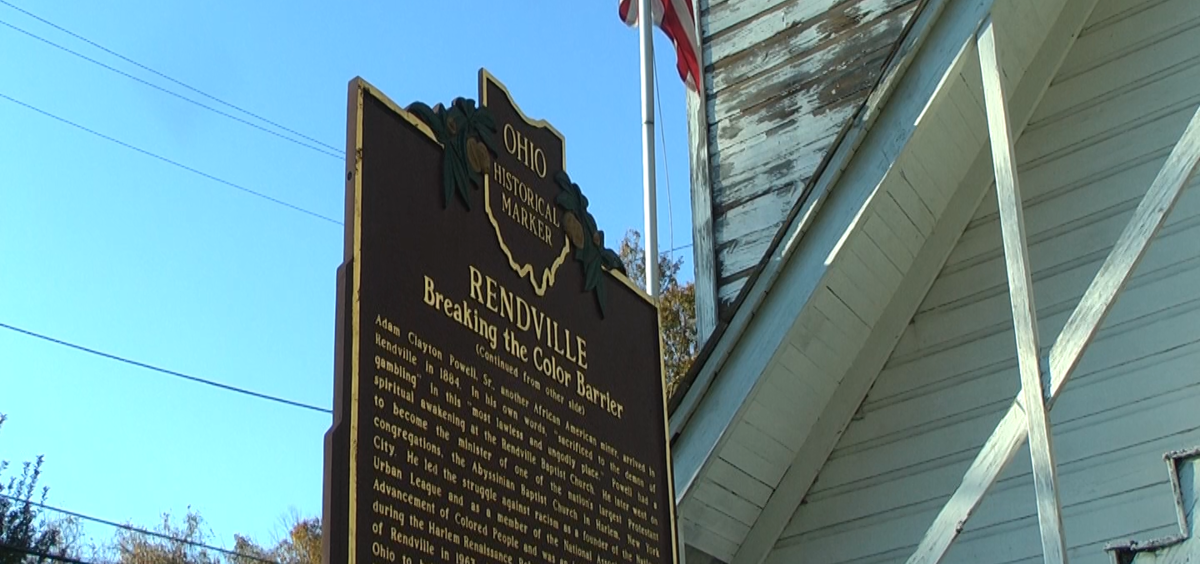
Learning From the Past: The Story of Rendville, Ohio
By: Kristopher Perez
Posted on:
Southeastern Ohio is known for its rolling hills, scenic views and its rich Appalachian history. Small villages nestled in the valleys of Athens, Perry and Hocking counties make up “Little Cities of Black Diamonds,” former coal mining towns that brought workers from near and far to achieve the common goals of landing a job and making money.
Sitting about 25 miles north of Athens is the small coal mining town of Rendville. The town is so small, it’s easy to miss — the only indication of its main street is a historical marker. A small white church stands at the end of the street. Some of the houses there are now vacant, their owners either passed on or moved away with no family interested in moving back in.
City hall, a two-story white building at the other end of the street, shows its age. Chipped paint flakes from the exterior and the only sounds that can be heard in the afternoons is the American flag flapping in the wind.
But you shouldn’t be fooled by the near silence here. Rendville’s contribution to this region, and to equality, speaks loudly and clearly for anyone who takes the time to read that historical marker.
This village, established in 1879 by William P. Rend, was the first integrated village in the state of Ohio.
Learning From the Past
Many “Firsts” of Rendville
It was all about the sense of community and ethnic diversity that moved the town of Rendville forward. It was progressive for its time.
Everyone in the town looked out for everyone else, and on the backs of those who lived in the village came people like Isaiah Tuppins, Roberta Preston and Adam Clayton Powell Sr., notable figures that went on to make an impact.
Isaiah Tuppins, the first mayor of Rendville, was African American. He was also the first African American man to earn his medical degree in Ohio at the Columbus Medical College which is now The Ohio State University. Tuppins was critical in protecting the rights of the African American majority in Rendville.
Rendville stood apart from the other coal mining towns in the area, who often had white minors who disapproved of William Rend’s hiring of immigrants from Europe and African Americans.
Roberta Preston was the first African American to serve as postmistress in Ohio and the United States. Adam Clayton Powell Sr., the pastor who developed the Abyssinian Baptist Church in Harlem, also has roots in Rendville.
“It’s just amazing to see what the people that came through Rendville accomplished,” Jackson said. “When I look back on it now and think about the people who lived there … it just gives you a feeling of being proud that you are from Rendville.”
Rendville Then & Now
While Rendville’s history runs deep, some of the residents have been trying to preserve the memory of the important historical figures who came through Rendville.
Former residents, including Ohio University Hall of Famer Jerry Jackson, got together to form the Rendville Historic Preservation Society. Their goal? To leave a legacy for future generations through the preservation of the history, heritage, and the physical structures of the Village of Rendville.
As president of the RHPS, Jackson wants the younger generation to hear about what he experienced growing up in Rendville in the 1950s.
“It was a quiet little town,” he said. “When I was growing up the streets were dirt, so we did a lot of playing in the streets – [we played a lot of] basketball or football.”
When asked about the current political climate and divisiveness in our country today, Jackson pointed to Rendville as an example – the story of the small village in the middle of nowhere, with a reported population of 34, had an impact unlike any other at the time.
“It’s very divisive now, but it was amazing to see how a small village like Rendville got along earlier in the 19th century,” he said. “Growing up there was never any racial tension or anything like that.”
“It was an integrated, coal mining town … there were a lot of immigrants from different countries. There didn’t seem to be any problems there in Rendville … they were there to work and that’s what they did. They worked with each other, and everybody got along just fine,” Jackson said.
With racial tensions being the highest they’ve been in the United States, it’s almost as if we’re moving backward. Rendville, as far back as 1879, was an example of a community that looked out for one another. The people of Rendville all had the same goals – they worked together regardless of race.
It’s instances like these, moments in history, where we can learn from the past in order to avoid repeating what has already occurred. Rendville can be used as an example for what could be if we all got along and treated each other with respect.
“The goal then was to work in the coal mines. That’s what they came there for and that’s what they did,” he said. “They lived together, they worked together, they went to church together … the goal financially was just to make money and work. People got along there in Rendville just by living together and trusting each other.”

